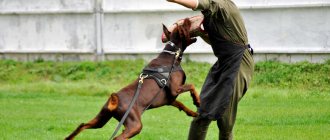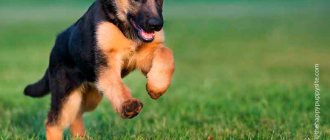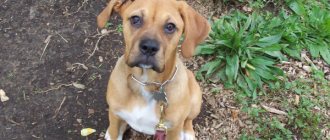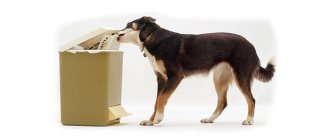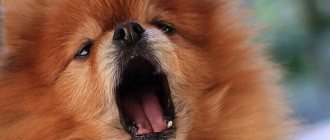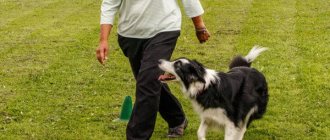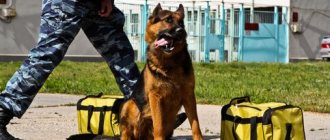When purchasing a puppy of any breed, every owner hopes to raise the pet to be obedient and obey any commands. Some people prefer to work with their four-legged friends on their own, while others turn to dog handlers for help, but everyone has the same goal - raising a dog. The basic commands that we are used to teaching dogs allow us not only to facilitate the interaction between humans and animals, but also to ensure the dog’s safety during walks and when in contact with other animals, including representatives of the canine family. In addition, an obedient dog socializes faster and gets used to its surroundings.
Regardless of whether you plan to train your dog in a basic obedience course, or want to take this process more seriously and prepare it for a professional search for missing people and objects, it is important to have patience, treats, and most importantly, time. After all, this may take more than one week or even one month. You should also keep in mind that different breeds respond differently to training. Some of them have hunting and search abilities inherent in their genetics, while others, on the contrary, may have more developed protective properties. Today we will try to answer the question of how to teach a dog the search command.
Tired of chasing your dog? Book an active walk!
Find out more
submit your application
The importance and benefits of games aimed at searching
It just seems like search games are too simple, but in fact they are the best activity for your pet! Search games are for dogs:
- mental excitement;
- physical stimulation;
- developing a sense of confidence;
- training for work;
- an easy way to express yourself and be closer to a person.
Searching is also an easy way to keep your pet entertained on a rainy day when you can't go out much. Dogs love this kind of work, especially since it is presented in a playful and exciting way. By using search commands, you use your talent in a constructive way and stimulate your puppy to think. According to most dog trainers, the “find” or “search” command is one of the most versatile and fun games you can engage your dog in.
How to teach a dog to search by smell while playing: preparation
You can teach your dog to smell tracks on the ground, scents in the air, and find hidden scented objects. All three skills can be taught at the same time because they use similar principles. You can start training at 6 weeks, but, in general, you can train a dog to search at any age!
- Before starting classes, decide on the teams . To search for objects: toys, money, mushrooms or food, use the “search” command; to find people, the “search” command is suitable. Never confuse these commands, then the dog will understand what exactly is required of it.
- Choose a place to train your dog . Training can be done indoors or outdoors. But you must understand that weather disasters, such as wind, temperature, high humidity, can affect the quality of olfactory molecules, so it is better to practice outside in calm, dry weather for the first time. Another important point: if you are training a pet, it is necessary to eliminate potential distractions during this time, such as noise, other pets, unusually bright light, etc.
- Select an object to track . There are many ways to hone your dog's natural instincts, but the best option for most animals is a favorite toy. If you decide to use an item, you cannot change it for several classes in a row.
- Prepare your dog for training by playing with him . In order for the learning process to be successful, do not start classes without playing with the student. A fifteen-minute warm-up before training will help the dog not to be distracted and perceive training as a continuation of fun.
- Learn a basic set of commands . If you decide that your puppy should become a search dog, first teach him basic commands, such as “sit”, “lie down”, “near”, “voice”, “fu”. This way you can discipline your pet, and in addition, you can easily manage the process. You can find out how to do this quickly and correctly in the “Dog Training” section.
- Use a leash . The search cannot be left to chance. The dog must be leash trained.
How to teach a dog the seek command
There are several very simple techniques:
First stage
- In which hand ? This is the simplest and most effective game: hide the treat and give the command “search”. If the puppy smells the gift, give it back and praise the clever girl. If the puppy doesn’t guess correctly, just show your empty palm and continue the game again.
- Hide the toy . First, you need to awaken your instincts, so preparation for the main work should first of all include searching for an object that is familiar and loved by the puppy. Give the command “sit” and hold the toy in front of the animal’s nose. Then hide the item, allowing your pet to see where you placed it.
- Give the command “search” . At this time, the dog should be on a leash - this will make it possible to control its movements. Don't be angry if the puppy misunderstands what you are trying to achieve; some animals take time to understand the command. If your dog needs extra help, use a leash to guide him to the hidden toy. When the pet takes the toy in its mouth, lead it to the starting place, then take the object away, rewarding the student with something tasty.
- Learn to choose from several items. Lay out several other people's items and one of yours - preferably a glove. Let the dog sniff your hand and offer to search, rewarding only for your item.
Second phase
It is worth moving to this stage only when the first stage has been completed and is being performed flawlessly.
This time, hide the toy where the dog can't see it. First, give your dog a good sniff of the “training aid.” For a new, greater challenge, hiding the item so that it is out of sight will force the pet to use its nose rather than its eyes. You can hide the toy in another room, under furniture or clothes. Give the command “look”, after the allowance is found and brought, be sure to reward the puppy.
Hide yourself. If your dog doesn't immediately find you by scent, give him a sound signal, such as a whistle or clap. Gradually everything will get better, especially if you do not skimp on praise and feeding.
Selecting an item based on the smell of a stranger - the “search” command
When the dog confidently begins to choose an item with your scent from all the things, move on to a more complex lesson: choosing an item based on the smell of a stranger. You will need two assistants (possibly one of the dog walkers). One should split a piece of log (block) and bring small, identical-looking logs. Before your eyes (you are standing in front of him with a dog sitting at your feet), spread them out and step aside.
Another assistant should come up and take two chocks, rub them both with your palms, put one with the others, and take the other to you. Holding the dog's mouth, let the dog sniff the chick (if necessary, force it to sniff), commanding “sniff.” Put away your little dog and send the dog to choose an item using the command “look”, when it runs up to the items, command “sniff, sniff”. After the dog correctly selects the item based on the smell of a stranger, reward with your voice “smell well.” Take the object with the command “give” from a sitting dog, reward it with a treat.
Be extremely careful when applying scents. I had a case when the judge knocked down my pet’s skill in choosing an item: he not only left his scent on two items, but by putting the one he was looking for in a pile, he corrected others that had been knocked down by a gust of wind. But that's a different story.
Stage four: how to teach a dog to look for money
This game allows you to show your pet how important his sense of smell is to you. Dogs love to feel useful, and this game especially helps boost confidence and self-importance.
As you walk, quietly drop an object from your pocket. Having continued walking 10-15 steps, stop, showing concern, for example, patting your pockets and looking around, saying: “where is my watch”, where is it, “where did it go”, etc. Return back to the place where you dropped the thing, encourage the dog and offer to look for the object. If the puppy does not find what he needs, lightly kick the “help”, but do not show that you see the little thing. When your puppy finally discovers what's missing, praise him! Believe me, dogs understand everything perfectly and are very proud if they manage to help or achieve something.
Throw in gloves and other large items first, then you can move on to metal objects. This is already a difficult task, since metals are practically odorless. At the same time, this does not mean that your dog will not be able to find them, just that the animal's reaction may vary, and it will probably take longer to get used to such searches.
Another task in which you will need a friend's help. Ask a friend to hide the item in front of the dog and move away. Give the command “search” to the dog, it is guaranteed to bring the desired item. Then you need to repeat the procedure, but using a more secluded place. Try not to say anything to the dog before searching so that he is not distracted by your voice.
Masters of smell
We have 6 million olfactory receptors, dogs have up to 300 million. The part of the brain that is responsible for analyzing these odors is 40 times larger in the dog brain compared to the human brain. This allows the dogs to find lost tourists, dig up truffles from the ground, or even smell a corpse at the bottom of a river. It seems reasonable to exploit these extraordinary abilities in our pets.
Where once a dog's survival depended on scent, now domestic dogs are a little lacking in practice. The good news is that with time and patience, you can introduce training into your dog's repertoire and help him finally take advantage of his superpower and teach the dog to search for objects by smell.
Search training with a track line: a dog searches for people
This method is necessary if you teach the dog to look for people by letting them smell an object, or other things, for example, again mushrooms or money.
The track line guarantees better training for the dog: in fact, it is a long leash from which the track is lined. The line serves as a means of communication between you and your dog, and prevents him from being distracted while searching. Track lines are usually made of rope, leather or cord. When choosing a material for a track leash, keep in mind that the rope can injure your hands, so you need to use it with gloves. The leather will stretch and crack over time. A special tarpaulin harness may be heavy to carry, but it will last a long time. The ideal thickness of the strap is 1.5 cm, the length required is up to 45-50 m.
Start your training early, preferably at 6 a.m., before anyone walks on the grass where you have set up the track. Lay the tourniquet on the ground in a large open space. Mark several points with flags, pieces of food and arrange two objects. The first object will be the object that the dog needs to find, the second object will serve as a guide, you will let your pet smell it before he starts looking. Your socks, gloves and other wearable items are ideal for this purpose. To prevent the scent from changing, the second object should remain in a plastic bag until you give your dog the “search” command.
Place flags at the beginning of the line, at the end, and place a couple between them. Place the food in very small pieces, and place the second item at the very end. After completing the laying of the track, return back to the dog, but not along the path, but by jumping to the side so as not to trample your own tracks. It is best to start searching using a leash. Only after the skills have been consolidated should you give your pet freedom.
Let your puppy sniff the object, then follow him, rewarding him with bits of treats if the dog follows your trail correctly. When the dog finds the second object, praise him and give him a treat))) You can start with a little trick - let the dog smell the “tasty” trail. This can be done this way: you need to crush the food into the grass with a shoe; various burgers from McDonald's and other eateries are great, as they are richly flavored with flavors and have a strong smell. The smell of fast food will also remain on the legs, which is very good, so the dog will be able to smell the scent perfectly. Start by letting your dog sniff the glove you were holding the sandwich in, then set the dog on the trail. Place a piece of treat on the second item, for example a glove, placed at the end of the line. Do not be afraid that the puppy will then react only to the smell of food. She knows and distinguishes your scent very well, but food will serve as a good motivator for her search. Each time, add 10 steps to your search, and reduce the level of smell.
Challenge your dog on more advanced tracks. Once the puppy has mastered the short straight trail, add distance including turns, loops, etc. Then learn to look for other people's objects.
To teach how to look for other people, you will again have to resort to cunning. Let your helper tease your dog with a brightly colored toy or treat. As soon as the dog begins to rush, the assistant must run away, gradually lengthening the route and hiding behind bushes, in the grass, etc. Over time, the partner needs to complicate the task, hiding in the wind, running through puddles, looping, etc. As soon as the skills are consolidated, close your pet’s eyes while your assistant is hiding, this will “turn on” the sense of smell.
Homeschooling
There is no need to rush and start classes earlier than 7-10 months; by the beginning of the course, the pet must be able to follow the commands Seek and Sniff, the pet must clearly perform Fu, Come to me, Place, Sit, Lie, Near, and, if necessary, Voice.
We call the pet to you in a playful manner, twirl a piece of sausage in front of its nose, preventing it from grabbing the treat, and give the command “Sniff.” We give away the treat. We tie the dog so that it can see you clearly. We take another piece of sausage, give the command “Sniff” and hide the treat under a towel, not far from the dog. Next, the leash carabiner is removed and at the same time the command “Look” is given to the dog. Naturally, the pet buries its nose in the towel and receives a reward.
If you perform the “Search” command flawlessly at the “beginner” level, we complicate the work. They secured the dog, gave the command Place and hid the treat in another room. They approached the pet, gave it a sniff of a treat or their hands, unfastened the carabiner, waved it in the right direction and with the command “Look”, sent the “detective” to work. We complicate the exercise by placing a treat in a rubber toy or a tennis ball, then we send the pet to search for family members (the dog must clearly know who is dad, mom, son or the cat Murzik in the house). For each find, the ward receives a generous reward and a flurry of positive emotions from the owner.
Important! Work from home as often as time allows. For a dog, searching for sausages is a very enjoyable game that strengthens the relationship with the owner and helps in the development of logical thinking.
Field training
After all the “home corners” have been studied, we move on to outdoor activities. This is where the real “school” begins, every day new smells and sounds that distract. In addition, you, as a coach, introduce new game conditions:
- Find an object (person) and sit next to it.
- Find, sit next to and vote.
- Finding and eating is the most pleasant, but not recommended method. Picking up food from the ground is a negative habit, even if it is something tasty from your hands.
A few important points
The dogs were bred to work with us: teach them to use their talent of smell, give them the opportunity to express themselves and be useful! Our pets feel good when they feel like they are helping us. But, remember, the dog must develop physically, but it cannot be tormented by hard work. There should be moderation in everything, including games and learning! We are responsible for those we have tamed! To find out how to add games to your training, read here.
Alena Gerasimova (Dulles)
